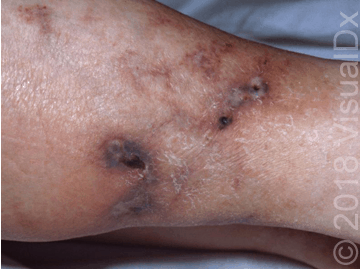Published on

Diagnosis
This patient was diagnosed with livedoid vasculopathy (LV), also known as livedoid vasculitis. LV is a rare condition, with an estimated incidence of 1:100 000 per year. Incidence increases during summer months and in pregnancy. It tends to affect middle-aged individuals and has a female-to-male ratio of 3:1.
Learnings/What to Look for
- LV is characterized by hyalinization of vessels, causing thrombotic disease with or without ulceration, which may progress to end-stage atrophic scarring known as atrophie blanche on the lower legs
- Pathogenesis of LV is not well understood, but it has been suggested that the occlusion of dermal vessels with fibrin thrombi may contribute to its development
- LV can be idiopathic
Pearls for Urgent Care Management and Considerations for Transfer
- The main goals of treatment are pain management and prevention of ulceration and progressive scarring
- Treatment with antiplatelet drugs, systemic anticoagulants, and fibrinolytic therapy has been shown to be effective. Colchicine, hydroxychloroquine, vasodilators, intravenous immunoglobulin, folic acid, immunosuppressive therapy, and supportive measures may also be beneficial
A 72-Year-Old Female with Lesions on Her Lower Legs
1 2
